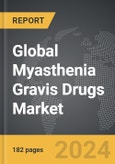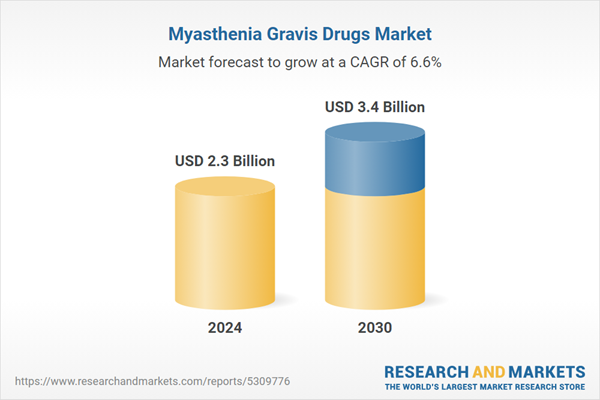The global market for Myasthenia Gravis Drugs was valued at US$2.3 Billion in 2024 and is projected to reach US$3.4 Billion by 2030, growing at a CAGR of 6.6% from 2024 to 2030. This comprehensive report provides an in-depth analysis of market trends, drivers, and forecasts, helping you make informed business decisions. The report includes the most recent global tariff developments and how they impact the Myasthenia Gravis Drugs market.
Segments: Treatment (Drug Treatment, Rapid Immunotherapies).
Geographic Regions/Countries: World; United States; Canada; Japan; China; Europe (France; Germany; Italy; United Kingdom; and Rest of Europe); Asia-Pacific; Rest of World.
The analysts continuously track trade developments worldwide, drawing insights from leading global economists and over 200 industry and policy institutions, including think tanks, trade organizations, and national economic advisory bodies. This intelligence is integrated into forecasting models to provide timely, data-driven analysis of emerging risks and opportunities.
Global Myasthenia Gravis Drugs Market - Key Trends & Drivers Summarized
What Is Myasthenia Gravis and How Are Drugs Used to Manage the Condition?
Myasthenia gravis (MG) is a chronic autoimmune neuromuscular disorder that causes muscle weakness and fatigue. It occurs when the immune system mistakenly attacks the communication between nerves and muscles, particularly affecting voluntary muscles such as those controlling the eyes, mouth, throat, and limbs. This condition is rare but requires long-term management through a variety of drug therapies aimed at improving muscle strength and inhibiting the abnormal immune response. Myasthenia gravis drugs are designed to reduce symptoms, slow disease progression, and improve patients' quality of life. Treatments typically include acetylcholinesterase inhibitors, corticosteroids, immunosuppressants, and newer biologic therapies that target specific components of the immune system. As research progresses, a growing number of therapeutic options are becoming available, offering hope for improved management of this debilitating condition.How Are New Treatment Approaches Shaping the Myasthenia Gravis Drugs Market?
Recent advancements in immunology and drug development are driving significant changes in the treatment landscape for myasthenia gravis. Traditional treatments such as acetylcholinesterase inhibitors, which enhance neuromuscular transmission, remain essential for symptom control. However, newer approaches, particularly biologics, are targeting the underlying immune dysfunction with greater precision. Monoclonal antibodies, like eculizumab and rituximab, have shown promise by inhibiting specific components of the immune system involved in the disease's pathogenesis. Eculizumab, for instance, targets the complement system, a key driver of inflammation in MG, offering more tailored and effective treatment options for patients with refractory or severe cases. Additionally, advancements in gene therapy and stem cell research are opening new avenues for potential curative treatments. These novel therapies are providing patients with more options, particularly those who do not respond well to conventional treatments.How Is the Increasing Prevalence and Diagnosis of Myasthenia Gravis Impacting Drug Demand?
The growing awareness of myasthenia gravis and improvements in diagnostic techniques are leading to earlier detection and a rise in reported cases globally. While the condition remains rare, advancements in medical imaging and antibody testing have enabled more accurate and timely diagnosis, allowing healthcare professionals to begin treatment sooner. The aging population, particularly in developed countries, is also contributing to the increase in MG cases, as the disease is more prevalent among older adults. Additionally, a rising understanding of rare autoimmune disorders is prompting better education and awareness efforts within the medical community, leading to more frequent and accurate diagnoses. This growing prevalence of MG is driving demand for both established treatments and novel therapies, creating a competitive and dynamic pharmaceutical market.What Are the Key Growth Drivers in the Myasthenia Gravis Drugs Market?
The growth in the myasthenia gravis drugs market is driven by several factors, including advancements in biotechnology, increasing diagnosis rates, and rising investment in orphan drug development. The introduction of targeted biologic therapies, which offer improved efficacy and fewer side effects, is revolutionizing treatment options for patients with severe or treatment-resistant MG. The growing awareness of autoimmune diseases and their impact on quality of life is encouraging early diagnosis, leading to more patients requiring long-term medication management. Additionally, pharmaceutical companies are investing heavily in the development of new drugs, particularly as myasthenia gravis is considered an orphan disease, providing incentives for the development of innovative treatments. The aging population is another significant driver, as older adults are more prone to developing autoimmune disorders, further expanding the market for MG therapies. Lastly, favorable regulatory environments and fast-track approvals for rare disease treatments are accelerating the introduction of new drugs, contributing to market growth.Report Scope
The report analyzes the Myasthenia Gravis Drugs market, presented in terms of units. The analysis covers the key segments and geographic regions outlined below.Segments: Treatment (Drug Treatment, Rapid Immunotherapies).
Geographic Regions/Countries: World; United States; Canada; Japan; China; Europe (France; Germany; Italy; United Kingdom; and Rest of Europe); Asia-Pacific; Rest of World.
Key Insights:
- Market Growth: Understand the significant growth trajectory of the Drug Treatment segment, which is expected to reach US$2.0 Billion by 2030 with a CAGR of a 7.1%. The Rapid Immunotherapies segment is also set to grow at 5.9% CAGR over the analysis period.
- Regional Analysis: Gain insights into the U.S. market, valued at $647.4 Million in 2024, and China, forecasted to grow at an impressive 6.2% CAGR to reach $530.1 Million by 2030. Discover growth trends in other key regions, including Japan, Canada, Germany, and the Asia-Pacific.
Why You Should Buy This Report:
- Detailed Market Analysis: Access a thorough analysis of the Global Myasthenia Gravis Drugs Market, covering all major geographic regions and market segments.
- Competitive Insights: Get an overview of the competitive landscape, including the market presence of major players across different geographies.
- Future Trends and Drivers: Understand the key trends and drivers shaping the future of the Global Myasthenia Gravis Drugs Market.
- Actionable Insights: Benefit from actionable insights that can help you identify new revenue opportunities and make strategic business decisions.
Key Questions Answered:
- How is the Global Myasthenia Gravis Drugs Market expected to evolve by 2030?
- What are the main drivers and restraints affecting the market?
- Which market segments will grow the most over the forecast period?
- How will market shares for different regions and segments change by 2030?
- Who are the leading players in the market, and what are their prospects?
Report Features:
- Comprehensive Market Data: Independent analysis of annual sales and market forecasts in US$ Million from 2024 to 2030.
- In-Depth Regional Analysis: Detailed insights into key markets, including the U.S., China, Japan, Canada, Europe, Asia-Pacific, Latin America, Middle East, and Africa.
- Company Profiles: Coverage of players such as Alexion Pharmaceuticals, Inc., Bausch Health Companies, Inc., Catalyst Pharmaceuticals, Inc., CSL Limited, Curavac Inc. and more.
- Complimentary Updates: Receive free report updates for one year to keep you informed of the latest market developments.
Some of the 18 companies featured in this Myasthenia Gravis Drugs market report include:
- Alexion Pharmaceuticals, Inc.
- Bausch Health Companies, Inc.
- Catalyst Pharmaceuticals, Inc.
- CSL Limited
- Curavac Inc.
- Cytokinetics, Inc.
- F. Hoffmann-La Roche AG
- Flamel Technologies S.A.
- Galenica Ltd.
- GlaxoSmithKline PLC
- Grifols SA
- Lupin Pharmaceuticals, Inc.
- Mitsubishi Tanabe Pharma Corporation
- Novartis International AG
- Pfizer, Inc.
- Shire PLC
Tariff Impact Analysis: Key Insights for 2025
Global tariff negotiations across 180+ countries are reshaping supply chains, costs, and competitiveness. This report reflects the latest developments as of April 2025 and incorporates forward-looking insights into the market outlook.The analysts continuously track trade developments worldwide, drawing insights from leading global economists and over 200 industry and policy institutions, including think tanks, trade organizations, and national economic advisory bodies. This intelligence is integrated into forecasting models to provide timely, data-driven analysis of emerging risks and opportunities.
What’s Included in This Edition:
- Tariff-adjusted market forecasts by region and segment
- Analysis of cost and supply chain implications by sourcing and trade exposure
- Strategic insights into geographic shifts
Buyers receive a free July 2025 update with:
- Finalized tariff impacts and new trade agreement effects
- Updated projections reflecting global sourcing and cost shifts
- Expanded country-specific coverage across the industry
Table of Contents
I. METHODOLOGYII. EXECUTIVE SUMMARY2. FOCUS ON SELECT PLAYERSIII. MARKET ANALYSISIV. COMPETITION
1. MARKET OVERVIEW
3. MARKET TRENDS & DRIVERS
4. GLOBAL MARKET PERSPECTIVE
UNITED STATES
CANADA
JAPAN
CHINA
EUROPE
FRANCE
GERMANY
ITALY
UNITED KINGDOM
REST OF EUROPE
ASIA-PACIFIC
REST OF WORLD
Companies Mentioned (Partial List)
A selection of companies mentioned in this report includes, but is not limited to:
- Alexion Pharmaceuticals, Inc.
- Bausch Health Companies, Inc.
- Catalyst Pharmaceuticals, Inc.
- CSL Limited
- Curavac Inc.
- Cytokinetics, Inc.
- F. Hoffmann-La Roche AG
- Flamel Technologies S.A.
- Galenica Ltd.
- GlaxoSmithKline PLC
- Grifols SA
- Lupin Pharmaceuticals, Inc.
- Mitsubishi Tanabe Pharma Corporation
- Novartis International AG
- Pfizer, Inc.
- Shire PLC
Table Information
| Report Attribute | Details |
|---|---|
| No. of Pages | 182 |
| Published | April 2025 |
| Forecast Period | 2024 - 2030 |
| Estimated Market Value ( USD | $ 2.3 Billion |
| Forecasted Market Value ( USD | $ 3.4 Billion |
| Compound Annual Growth Rate | 6.6% |
| Regions Covered | Global |









